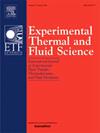利用高速成像和 PIV-PLIF 技术描述重力驱动蛞蝓流的发展特征
IF 2.8
2区 工程技术
Q2 ENGINEERING, MECHANICAL
Experimental Thermal and Fluid Science
Pub Date : 2024-10-11
DOI:10.1016/j.expthermflusci.2024.111334
引用次数: 0
摘要
尽管在石油、天然气和能源系统中经常出现重力驱动的蛞蝓流,但对其发展动态的探索仍然不足;而这一差距反过来又使得这些应用中的流动演变与传输现象之间的内在关系也没有得到充分描述。本研究通过实验研究了内径为 25.4 毫米的垂直管道中重力驱动的空气-水和二氧化碳-水蛞蝓流的时空谱发展。利用高速成像和粒子图像测速仪-平面激光诱导荧光(PIV-PLIF)等增强型流动可视化技术,确定了沿管道轴线四个位置的气相和液相行为及相互作用。采用基于机器视觉的算法提取蛞蝓单元特征和瞬时空隙率信号,从而对整个流域的气相行为进行全面的统计分析。此外,还开发了一种新型算法来预处理原始 PIV-PLIF 图像,以便在进行 PIV 交叉相关分析之前进行相位判别和降噪。结果表明,泰勒气泡、液体蛞蝓和蛞蝓单元的长度沿管道呈对数增长,液体蛞蝓占下游蛞蝓单元的近 60%。泰勒气泡长度分布与对数正态拟合关系良好,而液体蛞蝓和单元格长度则从上游的对数正态模式过渡到下游的接近正态分布,其形状更宽且峰值更小。泰勒气泡速度和流动结构的出现频率沿管道呈指数下降,泰勒气泡速度在下游呈现更窄、峰值更高的近似正态分布。瞬时空隙率信号显示出更少、更宽的波峰和波谷,下游的小振幅振荡减少。对这些信号的分析表明,在 Z/D=30 时,气泡完全转变为蛞蝓。气液相相互作用分为几乎为零、弱和强三种,对液相速度剖面和泰勒气泡的行为都有影响,观察到的最小稳定液滴长度为 8-9 D,唤醒长度为 1.8 D。建立的经验相关性代表了流动发展的时空-频谱方面,频谱参数,尤其是液滴频率,被确定为完全发展区域的最可靠指标,预测空气-水和二氧化碳-水的入口长度分别为 114.0 D 和 113.4 D。研究发现,气体密度对流动特性和过渡有很大影响,加速了向充分发展区的接近。本文章由计算机程序翻译,如有差异,请以英文原文为准。
Characterizing the development of gravity-driven slug flows using high-speed imaging and PIV-PLIF techniques
Although developing gravity-driven slug flow frequently occurs in oil and gas, and energy systems, its development dynamics remain underexplored; this gap, in turn, has left the underlying relationships between flow evolution and transport phenomena in these applications inadequately characterized as well. The present study experimentally investigates the spatiotemporal-spectral development of gravity-driven air–water and CO2-water slug flows in a vertical 25.4 ID pipe. Enhanced flow visualization techniques, utilizing high-speed imaging and particle image velocimetry-planar laser induced fluorescence (PIV-PLIF), were employed to determine the behaviors of gas and liquid phases and interactions at four positions along the pipe axis. A machine vision-based algorithm was employed to extract slug unit cell characteristics and instantaneous void fraction signals, allowing for a comprehensive statistical analysis of gas phase behavior across the flow domain. A novel algorithm was also developed to preprocess raw PIV-PLIF images, facilitating phase discrimination and noise reduction before PIV cross-correlation analyses are conducted. The results showed a logarithmic growth in the lengths of Taylor bubbles, liquid slugs, and slug unit cells along the pipe, with liquid slugs constituting nearly 60 % of slug units downstream. Taylor bubble length distributions correlated well with log-normal fits, while liquid slug and unit cell lengths transitioned from log-normal patterns upstream to near-normal distributions downstream with broader and less peaked shapes. Taylor bubble velocities and appearance frequencies of the flow structures declined exponentially along the pipe, with Taylor bubble velocities showing narrower and more peaked near-normal distributions downstream. Instantaneous void fraction signals exhibited fewer, wider peaks and troughs with reduced small-amplitude oscillations downstream. The analysis of the signals indicated a complete bubbly-to-slug transition at . Gas-liquid phase interactions, classified as almost-zero, weak, and strong, impacted liquid phase velocity profiles and the behavior of Taylor bubbles, with minimum stable liquid slug lengths of 8–9 and a wake length of 1.8 observed. Empirical correlations were developed to represent the spatiotemporal-spectral aspects of flow development, with spectral parameters, particularly liquid slug frequency, identified as the most reliable indicators of the fully developed region, predicting entrance lengths of 114.0 and 113.4 for air–water and CO2-water, respectively. Gas density was found to strongly influence flow characteristics and transition, accelerating the approach to the fully developed region.
求助全文
通过发布文献求助,成功后即可免费获取论文全文。
去求助
来源期刊

Experimental Thermal and Fluid Science
工程技术-工程:机械
CiteScore
6.70
自引率
3.10%
发文量
159
审稿时长
34 days
期刊介绍:
Experimental Thermal and Fluid Science provides a forum for research emphasizing experimental work that enhances fundamental understanding of heat transfer, thermodynamics, and fluid mechanics. In addition to the principal areas of research, the journal covers research results in related fields, including combined heat and mass transfer, flows with phase transition, micro- and nano-scale systems, multiphase flow, combustion, radiative transfer, porous media, cryogenics, turbulence, and novel experimental techniques.
 求助内容:
求助内容: 应助结果提醒方式:
应助结果提醒方式:


